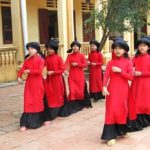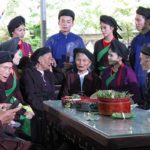Located in the heart of the capital, Hanoi’s Old Quarter is an enchanting neighborhood, filled with ancient streets, ancient buildings, and colorful markets. It is a bustling hub of activity, where the locals and tourists alike can find a variety of cultural and historical attractions.
Hanoi’s Old Quarter is an enchanting neighborhood, located in the heart of the city and covering an area of 82 hectares, including 10 wards of Hoan Kiem District. It is a treasure trove of Vietnam’s culture, history and architecture, bustling with activity and offering a variety of cultural and historical attractions. Here, locals and tourists alike can explore the ancient streets and buildings, as well as the vibrant markets, making it a great destination for those wishing to gain insight into the area’s rich heritage.
However, the development requirements of a modern city pose substantial challenges to those values.
Preserving priceless values is essential for the success and longevity of any organization. These values, such as integrity, honesty, and respect, must be cultivated and maintained in order to ensure that the company remains successful in the long run. By establishing and adhering to these values, organizations can create a strong foundation for success and ensure that their employees are motivated and inspired to do their best work. Additionally, organizations that prioritize these values will have a better chance of gaining public trust and earning customer loyalty. Ultimately, preserving priceless values is an investment in a company’s future, enabling them to achieve their goals and reach their full potential.
|
Hanoi’s Old Quarter is a fascinating destination that holds many of the beauties of the ancient capital of Vietnam. With a history of over one thousand years, the Old Quarter contains a wealth of cultural attractions, offering a window into the past. Stroll through the narrow streets, and you will find countless shops, markets, and restaurants, each with its own unique charm. There are also numerous temples and historical sites to explore, providing insight into the city’s fascinating past. Whether you’re looking for an unforgettable experience or simply a way to relax and take in the sights, a visit to Hanoi’s Old Quarter is sure to be an unforgettable one. |
The Old Quarter, located adjacent to Hoan Kiem Lake, is composed of 79 streets and bordered by Hang Dau Street to the north, Phung Hung Street to the west, Tran Quang Khai and Tran Nhat Duat Streets to the east, and Hang Bong, Hang Gai, Cau Go, and Hang Thung Streets to the south. With more than 200 historic houses of special value, the quarter also includes 121 temples, pagodas, and shrines.
A local initiative has been launched to improve the area.
The old neighborhood has slowly changed in appearance over time due to numerous variables, such as weather, urbanization, economic development, and population growth. Many structures have deteriorated significantly, while others are in danger of collapsing, putting the inhabitants in danger. In response to this, a local initiative has been launched to improve the area.
According to Professor Luong Tu Quyen from the Faculty of Urban and Rural Planning at Hanoi Architectural University, one of the greatest challenges facing the preservation of Hanoi’s Old Quarter is meeting the growing material, cultural, and spiritual needs of society. The alarming rate of change in the artifacts on the main streets is becoming increasingly difficult to control. The typical architectural shape is disappearing, resulting in streetscapes that have become distorted and disproportionate.
In order to effectively conserve relics, many nations have adopted successful policies and models, according to Dr. Architect Nguyen Quoc Tuan, Dean of the Faculty of Architecture and Engineering at Phuong Dong University. By implementing these initiatives, nations have been able to effectively safeguard their cultural heritage for future generations. For instance, in Vietnam, the government has established guidelines for the protection and preservation of historic and cultural relics, as well as the development of heritage preservation programs. Additionally, local communities are encouraged to participate in the preservation of their cultural heritage, and those who do are recognized and rewarded for their efforts.
Through the implementation of such initiatives, nations have been able to successfully protect and preserve their cultural heritage, ensuring its survival for future generations. This is essential for the continued appreciation and understanding of the shared history and culture of humanity.
| A motorbike repair shop in Hanoi’s Old Quarter. File Photo |
The city of Vancouver, Canada has implemented Heritage Revitalization Agreements to protect privately-owned heritage sites that are not designated as historical sites. These agreements bring both the city and the property owner great benefits, ensuring that historic urban architecture is not destroyed or lost.
In Sweden, local authorities have compiled a comprehensive list of protected historic structures, encompassing not only buildings and monuments but also their surrounding parks, gardens, and landscapes. Those who violate the laws regarding the preservation of these cultural and historical sites are subject to hefty fines.
Give Your Old Neighborhood a New Look
Are you looking to give your old neighborhood a fresh new look? Whether you’re looking to spruce up your home or give your local streets a facelift, there are plenty of ways to make your neighborhood more attractive and inviting. From installing new lights and sidewalks to adding art and landscaping, there are plenty of ways to give your old neighborhood a new look.
Start by considering how you want to improve the aesthetic of your neighborhood. Think about painting homes and buildings, adding outdoor art displays, and improving landscaping. You could also consider installing new streetlights, sidewalks, and benches to make your neighborhood feel more inviting. It can also help to add signs and banners to identify the area and make it seem more unified.
If you’re looking for more long-term improvements, consider partnering with local organizations to help fund and execute projects. These can include initiatives such as planting trees, improving public parks, or creating community gardens. You could also encourage businesses to open up shop in your neighborhood, as this has been shown to help increase the value of the area.
No matter what you decide to do, taking the time to give your old neighborhood a new look can help make it a more inviting and attractive place to live. With a few simple changes, you can make a big difference in your area and bring new life to your old neighborhood.
The vibrant residential culture of the Old Quarter has been preserved throughout the feudal and colonial periods, creating a living heritage. While intangible values such as customs and traditions are often lost over time, the architectural structures remain as a lasting reminder of the past. By exploring this area, visitors can gain insight into the history and culture of the townsfolk, making it a unique and fascinating experience.
The local authorities pay close attention to preserving, restoring, and promoting the heritage values of the old neighborhood through specific programs and plans. They are dedicated to ensuring that the cultural significance of the area is not lost to time.
Many monuments and spaces in the Old Quarter have been renovated and now serve as venues for cultural activities, art exchanges, exhibitions, seminars, and conferences on traditional crafts associated with craft streets and craft villages. This has helped to preserve and promote the area’s tangible and intangible cultural values.
| The Heritage House at No.87 Ma May Street in Hoan Kiem District, Hanoi. Photo: George Lai |
Typical locations to visit in Hanoi’s Old Quarter include the ancient house at 87 Ma May Street, the Kim Ngan Communal House at 42 Hang Bac Street, the Hanoi Old Quarter Cultural Exchange Center at 50 Dao Duy Tu Street, the Quan De Temple at 28 Hang Buom Street, the Dong Lac Communal House at 38 Hang Dao Street, the Arts and Culture Center (Cantonese Assembly Hall – 22 Hang Buom Street) and the Nam Huong Communal House at 75 Hang Trong Street.
In 2019, efforts have been focused on renovating French-style structures, such as June 1st Kindergarten (23 Nguyen Quang Bich Street), Trung Vuong Middle School (26 Hang Bai Street), the Hoan Kiem District police headquarters (2 Trang Thi Street) and Cua Dong Ward police headquarters (18 Nguyen Quang Bich Street).
In recent years, considerable progress has been made in the conservation, restoration, and promotion of heritage values in the Old Quarter and Hoan Kiem Lake area. Thanks to the concerted efforts of local authorities and the public, the stunning beauty of this heritage hub has been restored and preserved for future generations to enjoy. In addition, educational activities and campaigns have been launched to raise awareness of the importance of protecting the Old Quarter and Hoan Kiem Lake area, and to promote the unique cultural values they embody.
| A corner of Hanoi’s Old Quarter Area in the modern days. Photo: Cao Anh Tuan |
Undeniably, the Old Quarter has been a steadfast presence throughout the city’s growth over the course of more than 10 centuries, providing a unique and invaluable repository of heritage values. Despite the challenges posed by urbanization and modernization, this vibrant neighborhood has proven its resilience by adapting to remain both vibrant and resilient.
However, it is essential that all stakeholders come together to ensure the conservation of the area.
The Old Quarter of Hanoi is steeped in history and culture, holding a special place in the hearts of both modern Hanoians and the ancient Thang Long people. People’s Artist Tran Quoc Chiem, Chairman of the Hanoi Association of Literature and Arts, believes that the area is imbued with the spirit of the former Thang Long capital.
The area is a veritable wellspring of inspiration for dynamic artworks, and various art forms such as architecture, performance folk art, literature, cinema, dancing, theater, photography, fine arts, and more all play a crucial role in preserving the heritage of the Old Quarter.
Enhancing Operational Efficiency at Vietnam’s World Heritage Sites
NDO—Nhan Dan recently published a Vietnamese-language story calling for an immediate end to the organisation of parties in the caverns at Ha Long Bay, which revealed typical shortcomings in the management of World Heritage Sites in Vietnam. But we must look no further than some limitations of the current management model to uncover the main cause of such confusion.












